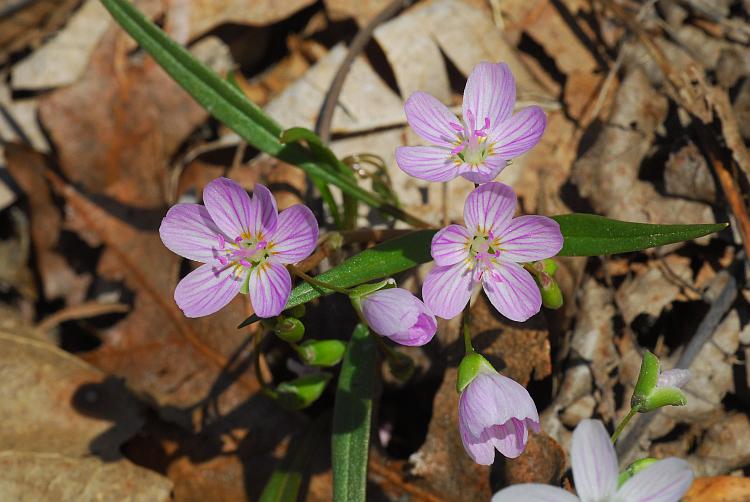Claytonia virginica L.
Virginia Spring Beauty

Native
CC = 3
CW = 3
MOC = 93
© SRTurner
Claytonia virginica L.Virginia Spring Beauty | |
 |
Native CC = 3 CW = 3 MOC = 93 |
© SRTurner |
|
Family - Portulacaceae Habit - Perennial forb with a globose, brown, tuberous rootstock, this 8-20 mm in diameter and usually deeply positioned. Stems - Loosely ascending to erect, 1 to several, 5-20 cm long, usually well-developed, sometimes sprawling, glabrous, often reddish in fruit.
Leaves - Basal and a single opposite pair along the stems, glabrous. Basal leaves 1 or few, 6-20 cm long, the blade relatively thick, linear to narrowly oblanceolate or narrowly elliptic (rarely broader), angled or tapered to a sharply pointed tip, long-tapered to an indistinct, short to long petiole, green to dark green, sometimes reddish-tinged. Stem leaves 4-15 cm long, sessile or with a short, indistinct petiole, the blade relatively thick, linear to narrowly oblanceolate or narrowly elliptic, occasionally broader, angled or tapered to a sharply pointed tip, long-tapered at the base.
Inflorescence - Terminal, solitary racemes 4-18 cm long, short- to long-stalked, with 5-18 flowers, all tending to be oriented to a single side of the axis, only the basal 1-2 flower(s) subtended by a membranous to herbaceous bract, this 2-9 mm long, narrowly lanceolate to ovate, more or less sheathing the axis.
Flowers - Relatively long-stalked, the stalk continuing to elongate after flowering, hypogynous Calyces 5-7 mm long, the 2 sepals overlapping, persistent at fruiting, remaining ascending after flowering. Petals 5, 7-14 mm long, white or pinkish-tinged, usually with pink venation, withering after flowering. Stamens 5, the anthers pink. Ovary superior, the style 3-branched above the midpoint.
Fruits - Capsules 2.5-5.0 mm long, ellipsoid to ovoid, longitudinally dehiscent, the valves remaining attached, the 1-6 seeds forcibly ejected. Seeds 1-3 mm long, more or less circular, somewhat flattened, the surface smooth, shiny, black.
Flowering - February - May. Habitat - Forests, prairies, bluffs and ledges, pastures, lawns. Origin - Native to the U.S. Lookalikes - Distantly, Thalictrum thalictroides, Hepatica spp. Other info. - This delightful springtime ephemeral is very common across Missouri and the eastern half of the U.S., and also ranges into Canada. It is easily recognized with its characteristic flowers and single pair of strap-like stem leaves. The corolla color is quite variable, with some being nearly white with invisible venation, ranging to specimens with highly pronounced pink venation. Photographs taken at Weldon Spring Conservation Area, St. Charles County, MO, 4-6-2011 and 3-22-2016, Engelmann Woods Natural Area, Franklin County, MO, 4-19-2014, and Glassberg Conservation Area, Jefferson County, MO, 4-30-2020 (SRTurner). |